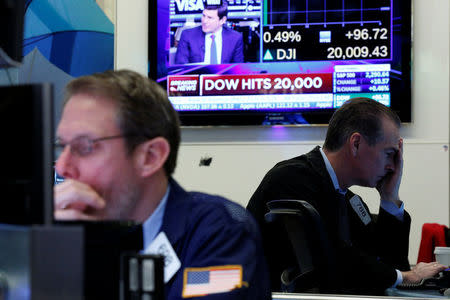Dow pops 20,000 and raises hopes rally is recharging
By Rodrigo Campos and Chuck Mikolajczak NEW YORK (Reuters) - The Dow Jones Industrial Average <.DJI> index's pop over 20,000 on Wednesday crowns a frenetic post-U.S. election rally that featured the second fastest-ever climb between 1,000-point milestones in the Dow's 120-year history. The rally, driven by enthusiasm over pro-growth policies from newly-minted U.S. President Donald Trump and an optimistic start to earnings season, has led to some speculation that stocks have run up too far. Analysts and investors, however, remain optimistic that the nearly nine-year bull run in equities will continue as long as the economy and corporate profits continue to show growth. "While the Dow hitting 20,000 is one of the least meaningful data points on my screen, it does suggest that the equity rally is pretty broad based," said Michael Purves, chief global strategist and head of derivatives research at Weeden & Co. "What's important is that the Dow is going up." The 42-session surge from the first close above 19,000 was driven by financial stocks, specifically Goldman Sachs and JPMorgan Chase , which were together responsible for more than 20 percent of the move. The fastest move between these thousand point milestones was 24 trading days between 10,000 and 11,000, from March 29 to May 3 of 1999. The rise from 18,000 to 19,000 took the Dow 483 trading sessions. Much of the gains have come from stocks expected to benefit as the administration moves to put its policies in place. Banks have been among the best performers since the Nov. 8 election of Trump, as investors bet that his expected fiscal stimulus will trigger inflation and bring higher interest rates. The largest contributor to the index's run from Nov. 22 was Goldman, which has single-handedly added over 170 points. Goldman is the only Dow component stock that trades above $200, so its influence in the price-weighted index is naturally larger. The President expressed his enthusiasm over the milestone, with a "Great!" tweet on the official Twitter account of the office. The advance has also been fueled by a solid start to quarterly earnings season, which has encouraged investors and helped equities resume their upward trajectory after consecutive weeks of modest declines. "In our view, investors have focused too much on Trump," said Maximilian Kunkel, Ultra High Net Worth Investment Strategist at UBS Wealth Management. "But it is clearly earnings that are driving the rally." Fourth-quarter earnings are now expected to show growth of 6.8 percent, according to Thomson Reuters data, marking the strongest growth in two years. RED FLAGS The rise from Nov. 22, when the Dow first closed above 19,000, has been so steep that the Dow is just over 2 percent away from hitting the level analysts expected at the end of 2017, according to the most recent Reuters poll. The pace of gains has caused some concern and increasingly cautious moves by some traders. The Dow's trailing price-to-earnings valuation is at 20.6 - the highest level in over seven years. "The big question for us is how much of that better earnings growth, or the anticipation of it, is already reflected in prices," said David Joy, chief market strategist at Ameriprise Financial in Boston. "We need that earnings growth to justify the multiples where they already are," he said. Some analysts have cautioned that stocks could also be held back if the administration's policies become bogged down in the political process as the year rolls on. Other potential pitfalls would be a strengthening dollar and a Federal Reserve that may move more aggressively than anticipated. "To the extent that there is room for disappointment on the policy side, we may see the market back away from these exuberant highs," said Bruce McCain, chief investment strategist at Key Private Bank, in Cleveland. Even if the Dow remains the proxy for stocks' performance for the person on the street, its importance as a benchmark has withered over time. A total of just $35.9 billion is indexed against it, compared with $2.1 trillion indexed against the S&P 500 <.SPX>, according to data from S&P Dow Jones Indices. Market watchers played down the significance of the round number hit as a psychological milestone but not a particularly meaningful one. "It's like watching your odometer cross over 100,000 or peeking up at the clock and noticing that it's exactly noon," said Brian Jacobsen, chief portfolio strategist at Wells Fargo Funds Management in Menomonee Falls, Wisconsin. "There are no magic numbers, but we like to pretend that there are." (Reporting by Rodrigo Campos, Lewis Krauskopf, Chuck Mikolajczak and David Randall; Editing by Megan Davies and Nick Zieminski)

 Yahoo Finance
Yahoo Finance 

